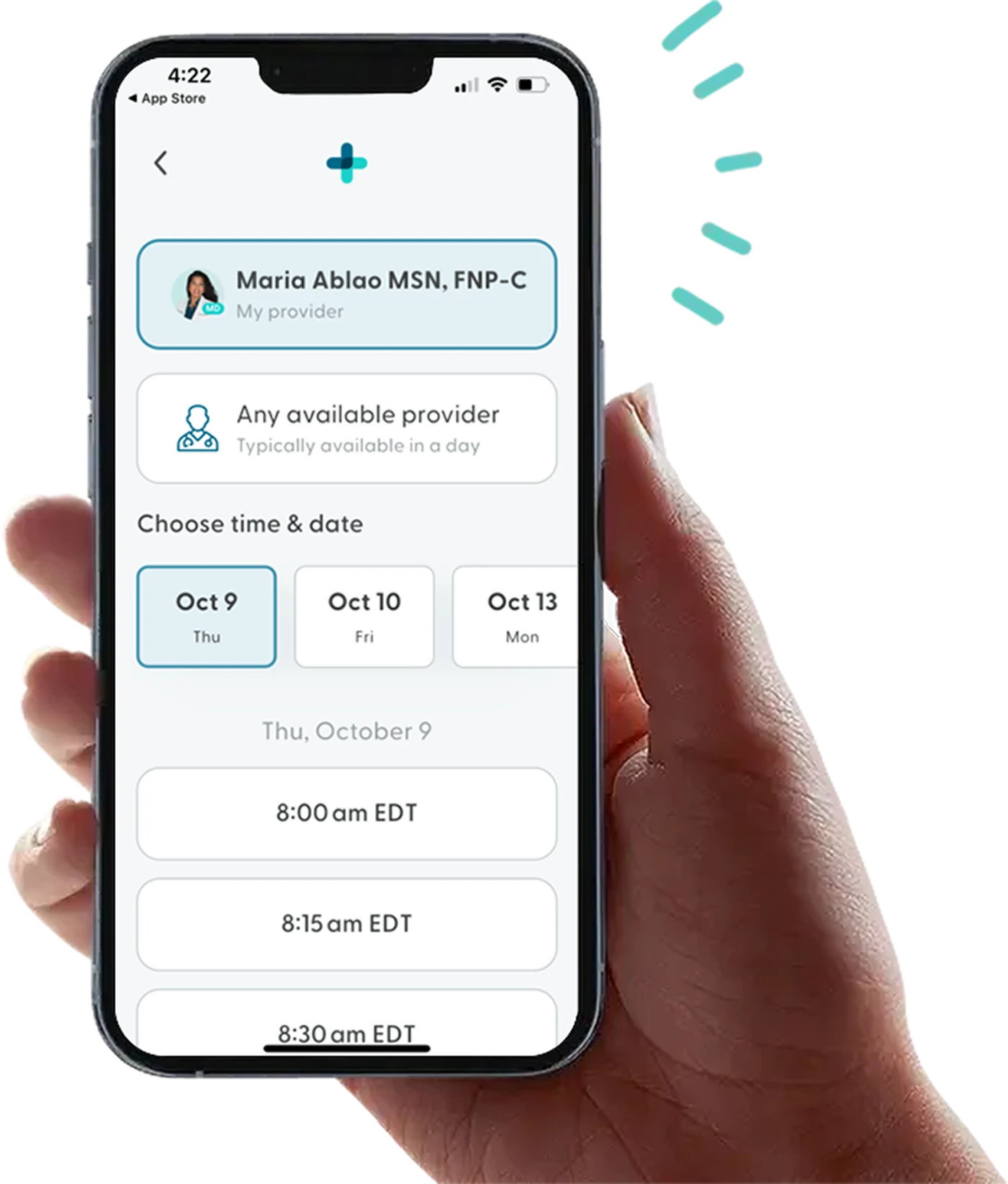Can You Be Allergic to Milk?
While a bowl of cereal in the morning or tall glass of milk with cookies can be a delicious treat for some, it can be life-threatening for others. For people with a milk allergy, this isn’t just an upset stomach – it’s their immune system overreacting to milk proteins, sometimes with dangerous consequences. Recognizing a milk allergy is crucial because symptoms can range from mild discomfort to life-threatening anaphylaxis.
Many people confuse a milk allergy with lactose intolerance, but they’re not the same – while a milk allergy involves the immune system, lactose intolerance is a digestive issue. We’ll break down the differences later.
Milk allergies are most common in infants and young children, but they can persist into adulthood or even develop suddenly in adults who previously had no issues with dairy.
Food allergies affecting your daily life?
Speak to a healthcare provider online about your allergy symptoms today.


What is a Milk Allergy?
A milk allergy occurs when the immune system mistakenly identifies proteins in milk – such as casein and whey – as harmful invaders. In response, the body triggers an allergic reaction, which can range from mild symptoms like hives or stomach pain to severe reactions, including anaphylaxis.
You may also hear the term cow’s milk protein allergy (CMPA), especially in reference to infants. CMPA is a specific type of milk allergy that primarily affects babies and young children, though some adults may also develop a milk allergy later in life. While the terms are sometimes used interchangeably, milk allergy is the broader term that applies to both children and adults.
Because milk is one of the top eight major allergens, U.S. law requires that packaged food products clearly indicate its presence on ingredient labels. Under the Food Allergen Labeling and Consumer Protection Act (FALCPA), any food containing milk or milk-derived ingredients must list it in plain language, helping people with milk allergies avoid accidental exposure.
What Causes a Milk Allergy?
A milk allergy develops when the immune system recognizes the proteins found in milk as harmful substances. This immune overreaction is what causes the symptoms of a milk allergy, ranging from mild discomfort to severe, life-threatening reactions.
Several factors can influence whether someone develops a milk allergy. Genetics play a significant role – if one or both parents have food allergies, asthma, or eczema, a child is more likely to develop a milk allergy. Environmental factors may also contribute, including early exposure to dairy, gut microbiome differences, and overall immune system health.
While milk allergies are most common in infants and young children, many outgrow them by early childhood. However, some people continue to have a milk allergy into adulthood, and in rare cases, individuals who previously tolerated dairy may develop a sudden milk allergy later in life. The reason for this late-onset allergy isn’t fully understood, but it may be linked to changes in the immune system, gut health, or prolonged exposure to allergens.
Milk Allergy Symptoms: How to Recognize a Reaction
Milk allergy symptoms can range from mild discomfort to severe, life-threatening reactions. Because the immune system overreacts to milk proteins, symptoms may affect multiple parts of the body, including the skin, digestive system, and respiratory system. The severity of symptoms depends on the individual and the degree of their milk protein allergy.
Skin reactions: A milk allergy rash is one of the most noticeable signs, appearing as hives, eczema, redness, or swelling.
Gastrointestinal issues: Many people experience vomiting, diarrhea, stomach cramps, or nausea after consuming milk.
Respiratory symptoms: These may include wheezing, coughing, nasal congestion, or shortness of breath – especially in those with a history of asthma or severe allergies.
Severe reactions (anaphylaxis): In some cases, a milk allergy can lead to anaphylaxis, a life-threatening reaction that causes swelling of the throat, difficulty breathing, a drop in blood pressure, and loss of consciousness. Anaphylaxis requires immediate emergency care and treatment with epinephrine.
Milk allergy symptoms in children vs. adults
Milk allergies are more common in infants and young children, who may develop symptoms soon after consuming formula or dairy products. Some children outgrow their cow’s milk protein allergy, but for others, the allergy persists into adulthood.
Adults with a sudden milk allergy may develop symptoms seemingly out of nowhere, often mistaking them for lactose intolerance at first. However, true milk food allergies involve the immune system and can cause more severe reactions than lactose intolerance, which only affects digestion.
Because symptoms can vary widely based on the severity of milk protein allergy, it’s essential to recognize early warning signs and consult a doctor for allergy testing and management strategies.
Key Point: Milk Allergy vs. Lactose Intolerance: What’s the Difference?
Many people confuse a milk allergy with lactose intolerance, but they’re completely different conditions. While both can cause discomfort after consuming dairy, the underlying causes and symptoms set them apart.
A milk allergy is an immune system reaction to milk proteins, such as casein and whey. The body mistakenly sees these proteins as threats, triggering allergic symptoms that can affect the skin, respiratory system, and digestive system. In severe cases, a milk allergy can lead to anaphylaxis, a life-threatening reaction that requires immediate medical attention.
Lactose intolerance is a digestive issue, not an immune response. It occurs when the body lacks lactase, the enzyme needed to break down lactose (the sugar in milk). As a result, undigested lactose ferments in the gut, causing symptoms like bloating, gas, stomach cramps, and diarrhea. Unlike a milk allergy, lactose intolerance does not involve the immune system and doesn’t cause rashes, breathing difficulties, or anaphylaxis.
Does Cooking Dairy Make it Safe for Those with a Milk Allergy?
For some people with milk protein allergy, consuming dairy in its raw or lightly processed form can trigger a strong immune reaction. However, heated milk proteins (such as those found in baked goods) may not cause the same response.
This is because high temperatures break down certain milk proteins, altering their structure enough that the immune system may no longer recognize them as a “threat”. This means that some people with a milk allergy (typically children with a milder form of CMPA) can tolerate dairy that has been baked.
That said, this isn’t true for everyone. Some people will still be highly sensitive to milk in any form, even if cooked. Because allergic reactions can be severe, anyone with a milk allergy should consult an allergist before trying baked dairy foods to determine what’s safe for them.
Managing a Milk Allergy: How to Stay Safe
Living with a milk allergy means staying vigilant about ingredients, potential cross-contamination, and emergency preparedness. Here are some tips to help you do so.
Read labels carefully
As previously mentioned, milk is one of the top eight allergens covered under FALCPA. That means that packaged food manufacturers in the U.S. must clearly state the presence of milk in ingredient lists. Always check for terms like casein, whey, lactalbumin, and milk solids when reading through ingredient labels.
Avoid hidden sources of milk
Milk can show up in unexpected places, including processed meats, baked goods, snack foods, and even some medications. When eating out, always ask about ingredients and potential cross-contact risks, especially with fried foods or sauces that may contain butter or cream.
Try dairy alternatives
Now especially you can find so many plant-based milk substitutes. Some options include:
Milk: Almond, oat, soy, coconut, pistachio, pea, and rice milk
Butter: Vegan margarine, coconut, olive, and avocado oil
Cheese: Dairy-free cheese made from cashews, almonds, soy, or tapioca
Yogurt: Coconut, almond, cashew, or soy-based yogurts – same goes for ice cream!
Be sure to choose options labeled dairy-free or vegan, as “lactose-free” products may still contain milk proteins.
Work with an allergist
Since milk protein allergy severity varies, an allergist can help determine your level of sensitivity. They can also advise whether you might tolerate baked dairy products and guide you in managing potential exposures.
Know what to do in case of emergency
Reactions can range from mild to severe, so it’s essential to have a plan:
Mild symptoms (hives, stomach discomfort): Antihistamines may help reduce symptoms but won’t stop a severe reaction.
Severe symptoms or anaphylaxis (trouble breathing, swelling, dizziness): Use an epinephrine auto-injector (EpiPen) immediately and call 911. Delaying treatment can be life-threatening.
By staying informed, carefully reading food labels, and having an emergency plan, managing a milk allergy becomes much more manageable.
How LifeMD Can Help
At LifeMD, you can speak with a licensed healthcare provider about what to do if you suspect you’re allergic to milk. They can give you tips for keeping yourself safe during an allergic reaction and safe foods to add to your diet.
Make an appointment today to learn more about managing a milk allergy.
More articles like this
Feel better with LifeMD.
Your doctor is online and ready to see you.
Join LifeMD for seamless, personalized care — combining expert medical guidance, convenient prescriptions, and 24/7 virtual access to urgent and primary care.

 Medically reviewed and edited by
Medically reviewed and edited by 








